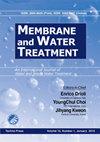Performance and antifouling properties of PVDF/PVP andPSf membranes in MBR: A comparative study
IF 0.8
4区 工程技术
Q4 ENGINEERING, CHEMICAL
引用次数: 1
Abstract
In this study, the performance and antifouling properties of polysulfone (PSf) and polyvinylidene fluoride/polyvinylpyrrolidone (PVDF/PVP) membranes in a membrane bioreactor (MBR) were investigated. The membranes were prepared via phase inversion method, and then characterized by a set of analyses including contact angle, porosity and water flux and applied in a lab-scale MBR system. Soluble microbial product (SMP), extracellular polymeric substance (EPS), FTIR, gel permission chromatography (GPC) and particle size distribution (PSD) analyses were also carried out for MBR system. The results showed that the MBR with PSf membrane had higher hydrophobic organic compounds which resulted in formation of larger flocs in MBR. However, in this MBR had high compressibility coefficient of cake layer was higher (n=0.91) compared to MBR with PVDF/PVP membrane (n=0.8); hence, the fouling was more profound. GPC analysis revealed that compounds with molecular weight lower than 2 kDa are more formed on PSf membrane more than PVDF/PVP membrane. The results of FTIR analysis confirmed the presence of polysaccharide and protein compounds on the cake layer of both membranes which was in good agreement with EPS analysis. In addition, the results showed that their concentration was higher for the cake on PSf membrane.PVDF/PVP和PSf膜在MBR中的性能及防污性能的比较研究
研究了聚砜(PSf)和聚偏氟乙烯/聚乙烯吡咯烷酮(PVDF/PVP)膜在膜生物反应器(MBR)中的性能和防污性能。通过相转化法制备了膜,并对其进行了接触角、孔隙率和水通量等表征,并在MBR系统中进行了应用。对MBR系统进行了可溶性微生物产物(SMP)、胞外聚合物(EPS)、FTIR、凝胶许可层析(GPC)和粒径分布(PSD)分析。结果表明,采用PSf膜的MBR具有较高的疏水性有机化合物,导致MBR中形成较大的絮凝体。与PVDF/PVP膜的MBR (n=0.8)相比,饼层的压缩系数更高(n=0.91);因此,污垢更加深刻。GPC分析表明,相对于PVDF/PVP膜,PSf膜上更多地形成分子量小于2 kDa的化合物。FTIR分析结果证实,两种膜的饼层均存在多糖和蛋白质化合物,这与EPS分析结果吻合较好。此外,结果还表明,聚砜膜上的滤饼中它们的浓度较高。
本文章由计算机程序翻译,如有差异,请以英文原文为准。
求助全文
约1分钟内获得全文
求助全文
来源期刊

Membrane Water Treatment
ENGINEERING, CHEMICAL-WATER RESOURCES
CiteScore
1.90
自引率
30.00%
发文量
0
审稿时长
>12 weeks
期刊介绍:
The Membrane and Water Treatment(MWT), An International Journal, aims at opening an access to the valuable source of technical information and providing an excellent publication channel for the global community of researchers in Membrane and Water Treatment related area. Specific emphasis of the journal may include but not limited to; the engineering and scientific aspects of understanding the basic mechanisms and applying membranes for water and waste water treatment, such as transport phenomena, surface characteristics, fouling, scaling, desalination, membrane bioreactors, water reuse, and system optimization.
 求助内容:
求助内容: 应助结果提醒方式:
应助结果提醒方式:


